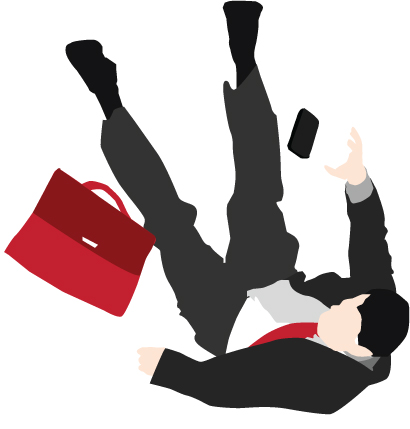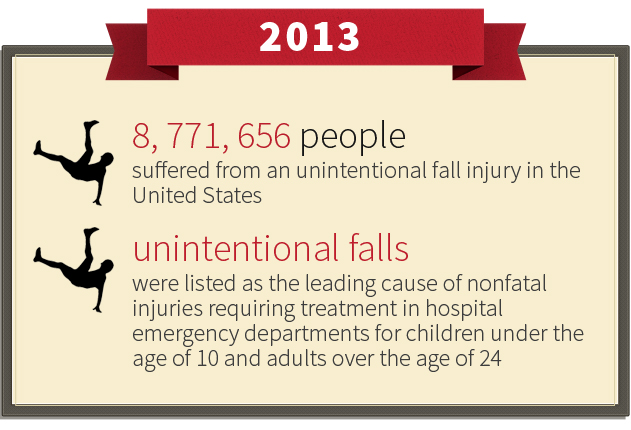You may have heard someone use the term slip and fall, but do you know what that really means? Some people believe slip and fall accident pose a threat only to the elderly or when weather conditions make it easier to fall. In fact, any individual can become the victim of a slip and fall accident, particularly when a property owner fails to use reasonable care to maintain a safe property.
If you or a loved one has become the victim of a slip and fall accident, or you have questions about whether you may have a slip and fall case, this blog will help give you the answers you need.

What is a Slip and Fall Accident?
A slip and fall is an accident in which an individual is injured in a fall on the property of another party. The person can be hurt in a number of ways, such as slipping on a wet floor, tripping on an uneven sidewalk, or losing footing on a hazardous stairway.
Not all slip and falls lead to legal action or insurance injury claims. The slip and fall must have been caused by the negligence of a property owner, manager, business owner, homeowner, or landlord..
The following scenario is an example: suppose a renter slips and falls outside his or her apartment building due to a leak from a broken pipe. If the landlord was unaware of the hazardous condition, or could not possibly have known the pipe was broken, no liability exists; the property owner must have either known and then failed to make the necessary repairs, or should have been aware that there was an unsafe condition, before an injury claim arises.
How Often Do Slip & Falls Happen?
Statistics compiled by the Centers for Disease Control and Prevention (CDC) indicate 8,771,656 people suffered from an unintentional fall injury in the United States in 2013, the latest year for which numbers are available. In that same year, unintentional falls were listed as the leading cause of nonfatal injuries requiring treatment in hospital emergency departments for children under the age of 10 and adults over the age of 24. Unintentional falls were the second leading cause of nonfatal injuries among children and young adults between the ages of 10 and 24.

While not all fall injuries are caused by an individual slipping or tripping on the same level, approximately 12 percent of all falls requiring hospital emergency department visits are slip and falls, according to the National Floor Safety Institute (NFSI).
The CDC also lists unintentional falls as the leading cause of death among people ages 65 and older, one of the top 10 leading causes of injury deaths among people between the ages of 15 and 64, and the third most common cause of injury-related deaths (30,208) in 2013.
How Do Slip and Falls Happen?
Slip and falls take place under a variety of circumstances and conditions. The majority of slip and fall accidents happen when there is minimal friction between shoes and the walking surface. When hazardous conditions exist, slip and fall accidents are far more common.. Some of the primary reasons a slip and fall could occur include:

- Uneven surfaces
- Escalators and moving walkways
- Dark stairwells
- Overall lack of sufficient lighting
- Wet floors
- Oily floors
- Broken steps or handrails
- Snow, ice and water on floors from weather conditions
- Spilled drinks or food
- Loose rugs or mats
- Smooth or slick walking surfaces
Where Do Slip and Falls Happen?
Slip and falls are extremely common in the workplace. According to statistics from the Occupational Safety & Health Administration (OSHA), 15 percent of all accidental workplace fatalities are caused as a result of a slip, trip or fall. The only larger cause of accidental death in the workplace is motor vehicle-related collisions.
Additional information from the NFSI indicates that slip and falls are:
- A key contributing cause of injury-related days away from work.
- The primary cause of workers’ comp injury claims
- The leading cause of work-related injury for workers ages 55 and older.
Slip and fall accidents in the home are also quite common, particularly among adults aged 65 years and older.. A report from the National Security Council (NSC) states that one out of every three adults falls each year and at least 95 percent of the reported 250,000 hip fractures among older adults can be attributed to falls.
A few of the other common environments where slip and fall accidents occur include sidewalks, poorly lit parking lots or garages, shopping centers, grocery stores, restaurants, construction areas, office buildings and around pools.. Anywhere water, ice, snow or any other slip and fall hazard exists, so does the risk of injury.
What Kinds of Injuries Do People Get from a Slip and Fall Accident?
When a slip and fall accident is relatively minor, a person may walk away with only a few bumps and bruises. In cases where a slip and fall accident is more severe, the kinds of injuries a victim is likely to get include:

- Sprained wrists or ankles
- Broken bones
- Hip fractures
- Back and spinal cord injuries
- Shoulder injuries
- Head or brain injuries
Falls are actually one of the most common causes of head trauma leading to brain injuries, according to CDC statistics. More than two-thirds of traumatic brain injuries (TBIs) in adults over the age of 64 and more than half of TBIs among children under the age of 15 are caused by a fall.
These injuries are often very costly and recovery time can be quite lengthy. The severity of the injury sustained will determine whether time away from work is necessary, in which case the individual could lose his or her primary source of income.
How Does a Slip & Fall Become a Legal Action?
Property owners have a certain duty to keep invited residents, visitors and guests reasonably safe. When that duty is breached and injury results, the property owner or individual whose negligence caused the injury needs to be held liable. Negligence is the key component in any slip and fall accident case..
If your injuries were caused as a direct result of another party’s negligence, you may be able to pursue compensation by filing a personal injury claim or lawsuit. Seek consultation with a skilled Boston slip and fall attorney to find out if you may have grounds to seek damages following a slip and fall.
Sources:
- CDC: National Estimates of the 10 Leading Causes of Nonfatal Injuries Treated in Hospital Emergency Departments, United States – 2013
- National Floor Safety Institute: Quick Facts
- United States Department of Labor: OSHA: Safety and Health Topics: Walking/Working Surfaces
- National Safety Council: Is it Time to Fall-proof Your Parents’ Home?
- CDC: Injury Prevention & Control: Traumatic Brain Injury: Traumatic Brain Injury in the United States: Fact Sheet

